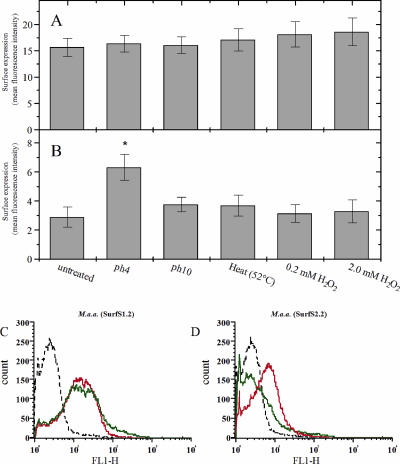FIG. 4.
Influence of extrinsic stressors or the intrinsic growth phase of M. avium subsp. avium (M. a.a.) on the subsequent patterns of antibody binding by scFv clones SurfS1.2 and SurfS2.2. (A and B) Live M. avium subsp. avium cells were subjected to pH stress (pH 4 and pH 10, 2 h), heat stress (52°C, 15 min) or oxidative stress (0.2 mM and 2.0 mM H2O2, 2 h) prior to incubation with scFv clones SurfS1.2 and SurfS2.2. Patterns of surface antigen expression were examined by flow cytometry, and data were expressed as units of fluorescence intensity due to the binding of SurfS1.2 (A) or SurfS2.2 (B). The asterisk indicates a significant increase in signal generation by pH 4-treated M. avium subsp. avium cells exposed to SurfS2.2 in comparison to nontreated control cells (P < 0.05). (C, D) M. avium subsp. avium cells were harvested at different phases of the growth cycle and labeled with scFv clone SurfS1.2 (C) or SurfS2.2 (D). Green lines represent antibodies incubated with fresh cultures (incubated for 4 days), red lines represent antibodies incubated with late-phase cultures (3-week incubation), and black lines represent signal obtained using a non-target-specific antibody. Note the down-regulated surface binding by SurfS2.2 in late-phase cultures (D).

